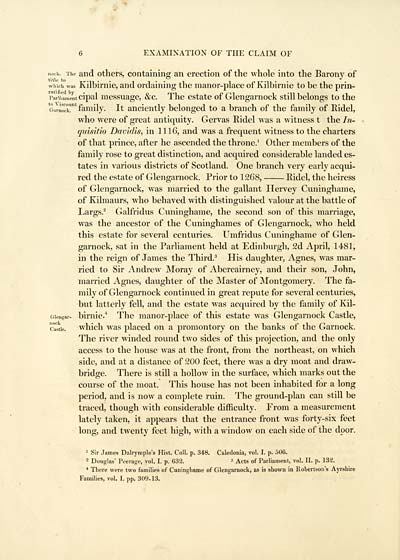Download files
Complete book:
Individual page:
Thumbnail gallery: Grid view | List view

6 EXAMINATION OF THE CLAIM OF
nock. The and others, containing an erection of the whole into the Barony of
whkh was Kilbirnie, and ordaining the manor-place of Kilbirnie to be the prin-
l'aniament cipal messuage, &c. The estate of Glengarnock still belongs to the
Gainwk" 11 ' family. It anciently belonged to a branch of the family of Ridel,
who were of great antiquity. Gervas Ridel was a witness t the In-
quisitio Davidis, in 1116, and was a frequent witness to the charters
of that prince, after he ascended the throne. 1 Other members of the
family rose to great distinction, and acquired considerable landed es-
tates in various districts of Scotland. One branch very early acqui-
red the estate of Glengarnock. Prior to 1268, Ridel, the heiress
of Glengarnock, was married to the gallant Hervey Cuninghame,
of Kilmaurs, who behaved with distinguished valour at the battle of
Largs. 2 Galfridus Cuninghame, the second son of this marriage,
was the ancestor of the Cuninghames of Glengarnock, who held
this estate for several centuries. Umfridus Cuninghame of Glen-
garnock, sat in the Parliament held at Edinburgh, 2d April, 1481,
in the reign of James the Third. 3 His daughter, Agnes, was mar-
ried to Sir Andrew Moray of Abercairney, and their son, John,
married Agnes, daughter of the Master of Montgomery. The fa-
mily of Glengarnock continued in great repute for several centuries,
but latterly fell, and the estate was acquired by the family of Kil-
Giengar- birnie. 4 The manor-place of this estate was Glengarnock Castle,
castle. which was placed on a promontory on the banks of the Garnock.
The river winded round two sides of this projection, and the only
access to the house was at the front, from the northeast, on which
side, and at a distance of 200 feet, there was a dry moat and draw-
bridge. There is still a hollow in the surface, which marks out the
course of the moat. This house has not been inhabited for a long
period, and is now a complete ruin. The ground-plan can still be
traced, though with considerable difficulty. From a measurement
lately taken, it appears that the entrance front was forty-six feet
long, and twenty feet high, with a window on each side of the door.
1 Sir James Dalrymple's Hist. Coll. p. 348. Caledonia, vol. I. p. 506.
2 Douglas' Peerage, vol. I. p. 632. 3 Acts of Parliament, vol. II. p. 132.
4 There were two families of Cuninghame of Glengarnock, as is shown in Robertson's Ayrshire
Families, vol. I. pp. 309-13.
nock. The and others, containing an erection of the whole into the Barony of
whkh was Kilbirnie, and ordaining the manor-place of Kilbirnie to be the prin-
l'aniament cipal messuage, &c. The estate of Glengarnock still belongs to the
Gainwk" 11 ' family. It anciently belonged to a branch of the family of Ridel,
who were of great antiquity. Gervas Ridel was a witness t the In-
quisitio Davidis, in 1116, and was a frequent witness to the charters
of that prince, after he ascended the throne. 1 Other members of the
family rose to great distinction, and acquired considerable landed es-
tates in various districts of Scotland. One branch very early acqui-
red the estate of Glengarnock. Prior to 1268, Ridel, the heiress
of Glengarnock, was married to the gallant Hervey Cuninghame,
of Kilmaurs, who behaved with distinguished valour at the battle of
Largs. 2 Galfridus Cuninghame, the second son of this marriage,
was the ancestor of the Cuninghames of Glengarnock, who held
this estate for several centuries. Umfridus Cuninghame of Glen-
garnock, sat in the Parliament held at Edinburgh, 2d April, 1481,
in the reign of James the Third. 3 His daughter, Agnes, was mar-
ried to Sir Andrew Moray of Abercairney, and their son, John,
married Agnes, daughter of the Master of Montgomery. The fa-
mily of Glengarnock continued in great repute for several centuries,
but latterly fell, and the estate was acquired by the family of Kil-
Giengar- birnie. 4 The manor-place of this estate was Glengarnock Castle,
castle. which was placed on a promontory on the banks of the Garnock.
The river winded round two sides of this projection, and the only
access to the house was at the front, from the northeast, on which
side, and at a distance of 200 feet, there was a dry moat and draw-
bridge. There is still a hollow in the surface, which marks out the
course of the moat. This house has not been inhabited for a long
period, and is now a complete ruin. The ground-plan can still be
traced, though with considerable difficulty. From a measurement
lately taken, it appears that the entrance front was forty-six feet
long, and twenty feet high, with a window on each side of the door.
1 Sir James Dalrymple's Hist. Coll. p. 348. Caledonia, vol. I. p. 506.
2 Douglas' Peerage, vol. I. p. 632. 3 Acts of Parliament, vol. II. p. 132.
4 There were two families of Cuninghame of Glengarnock, as is shown in Robertson's Ayrshire
Families, vol. I. pp. 309-13.
Set display mode to:
![]() Universal Viewer |
Universal Viewer | ![]() Mirador |
Large image | Transcription
Mirador |
Large image | Transcription
Images and transcriptions on this page, including medium image downloads, may be used under the Creative Commons Attribution 4.0 International Licence unless otherwise stated. ![]()
| Histories of Scottish families > Examination of the claim of John Lindsay Crawfurd > (26) Page 6 |
|---|
| Permanent URL | https://digital.nls.uk/95376035 |
|---|
| Description | A selection of almost 400 printed items relating to the history of Scottish families, mostly dating from the 19th and early 20th centuries. Includes memoirs, genealogies and clan histories, with a few produced by emigrant families. The earliest family history goes back to AD 916. |
|---|

